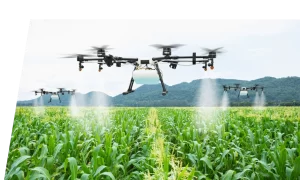
The era of relying solely on ground-level observations and instinct in farming is fading. Today’s agriculture demands heightened efficiency and accuracy, making unmanned aerial vehicles (UAVs), commonly known as agriculture drones, increasingly vital tools. Outfitted with advanced sensors and cameras, these aerial devices provide an overhead perspective of your fields, delivering crucial information that can transform your agricultural practices.
A primary application of agriculture drones lies in crop monitoring and health assessment. Equipped with high-resolution RGB, thermal, and multispectral cameras, drones can capture data across a range of light frequencies, including the near-infrared spectrum. This capability facilitates the early evaluation of plant health and the identification of stress indicators before they become apparent to the naked eye. By offering an extensive aerial view, UAVs enable farmers to efficiently survey their land, even across vast acreages, pinpointing potential issues or areas requiring attention.
Precision spraying stands out as another transformative use of agriculture drones. These specialized aircraft can apply pesticides, herbicides, and fertilizers with remarkable accuracy, targeting specific zones needing treatment rather than broadly spraying entire fields. This approach minimizes chemical waste, lessens environmental impact by limiting chemical drift, and can result in substantial savings on input costs. Certain advanced spray drones are also equipped with features like adjustable droplet sizes and atomized spraying mechanisms for consistent coverage.
Effective irrigation management is essential for maximizing water use, and agriculture drones are playing an increasingly important role in this area. Drones with thermal imaging capabilities can detect areas within your fields that are either excessively wet or dry, allowing for tailored irrigation strategies. By mapping irrigation patterns and identifying leaks or regions experiencing water stress, you can ensure your crops receive the optimal amount of hydration, promoting healthier growth and significant water conservation.
Beyond applications focused on crops, drones are also highly valuable for land mapping and soil analysis. They can survey your property, generating detailed topographical maps and 3D models that offer insights into soil composition, erosion potential, and drainage characteristics. This information is fundamental for making well-informed decisions regarding crop cultivation and the allocation of resources.
The utility of agriculture drones extends beyond crops to encompass livestock management. By providing aerial views of herds, drones can assist in counting animals and tracking their movements. Thermal imaging capabilities can further aid in detecting unusual body temperatures, which can indicate early signs of illness, enabling timely isolation and treatment of affected animals. This reduces the necessity for labor-intensive manual inspections and can enhance the overall health and safety of your livestock.
Moreover, drones can contribute to yield prediction by supplying real-time data on crop health and development, facilitating more accurate forecasting and improved planning for harvesting and market strategies. Certain drones are even equipped to collect soil and water samples, streamlining these vital tasks.
In conclusion, agriculture drones provide a comprehensive array of capabilities for modern farmers seeking to boost efficiency, increase yields, cut costs, and foster sustainability. From in-depth crop monitoring and precise spraying to optimized irrigation and livestock oversight, these adaptable machines deliver data-driven intelligence that empowers you to make informed choices and take prompt actions, ultimately leading to a more productive and profitable farming enterprise. As this technology continues to advance and become more accessible, agriculture drones are set to play an even more significant role in shaping the future of agriculture.





